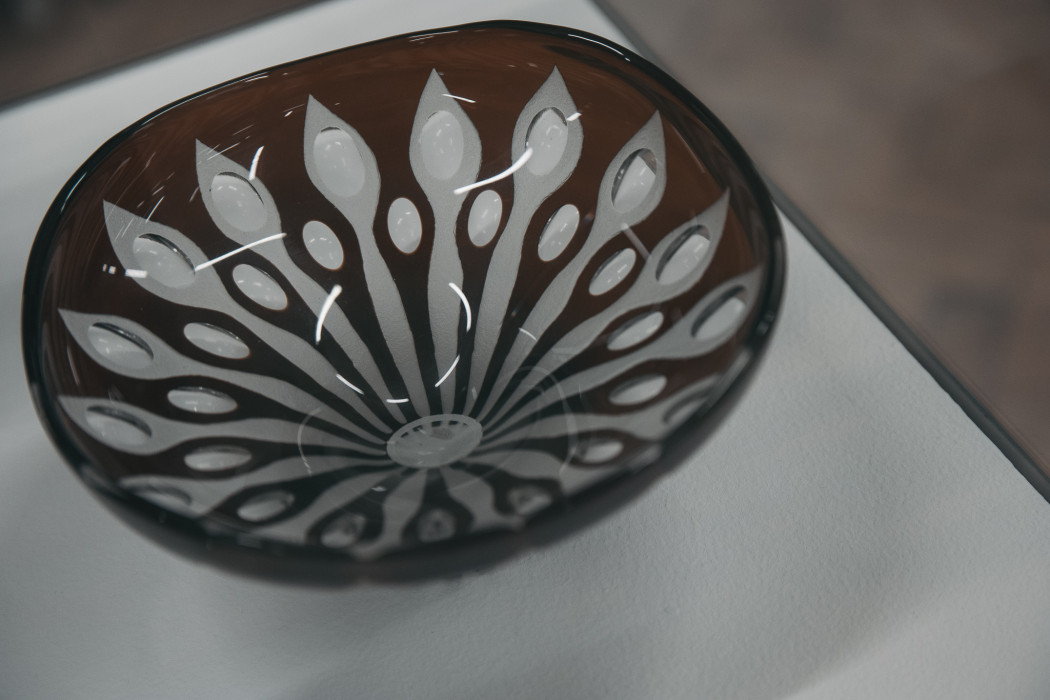“No one in England can imagine the Swedish attitude to industrial design. It’s not a job there – it’s a philosophy. They want ideas, not a neatly punched time card”
(Ernest Gordon Adsetts, as told to Peter Wilsher in 1956).
Sheffield-born Ernest Gordon Adsetts went from humble beginnings to becoming one of the leading figures in the Swedish glass industry. Born in 1926, in 1941 he enrolled at Sheffield College of Art to study sculpture, going on to win a scholarship to the Royal College of Art in 1946. There, and later at a studio in Chelsea, he worked with Sheffield-born sculptor George Fullard, notably on the temporary pavilions at the Festival of Britain, and on a model of the Queen’s Coronation coach at the 1953 Ideal Home exhibition. His sculpture from this time was also purchased for public spaces in the new town being built at Harlow, in Essex.
Drawn to the influential new design coming from Scandinavia, Ernest Gordon Adsetts decided in 1954 to move to Sweden, with “just a book of sketches, a lot of ideas and a Swedish wife”. Knowing nothing about working in glass he offered to “work a month without pay. If it went well, a month on half pay. And if that went well, one month with full pay”. At first he designed for internationally renowned firm Kosta with Vicke Lindstand, subsequently moving to the Åfors glassworks.
At Åfors, Gordon Adsetts found the perfect environment to nurture his work. Established in 1876, the company had a reputation for its cut and moulded glass – but by the 1950s the company’s sales of its main output were dwindling and Gordon Adsetts was appointed as part of a bid to modernise the product range and develop a line of luxury art glass. This was a critical moment for Swedish glass production – part of a conscious effort to promote ‘Scandinavian Design’ through international exhibitions in the 1950s, promoting the ‘Scandinavian way of living’, characterised by the use of natural materials like wood and stone, and virtuosity in glass, ceramics and textiles. Designer craftspeople were embedded in the industry, encouraged to produce individual pieces whilst also designing for batch or mass production of functional and beautiful artefacts that were available to all – what Katherine Nelson and Raul Cabra have characterised as ‘functionality, modesty, equality, beauty’. The Åfors works themselves, set in deep in the forests of Småland (originally offering an unlimited fuel supply for the works) with attached village, community hall and community of highly skilled craftspeople seem almost to offer a physical embodiment this philosophy.
At Åfors, Ernest Gordon Adsetts was given some considerable freedom to experiment “I didn’t design a single piece for six months, just spent my time drawing, modelling, wandering into the factory and picking up some of the elements of glass technology”. This freedom is very visible in the work – whether the whimsical storytelling of his etched pieces, or the playful variations on the effects of a particular technical process – for example trapping a bubble inside glass.
In 1961 he moved back to Britain, setting up the UK arm of Swedish lighting firm Konstsmide, and continuing to design lighting and candlesticks.
This exhibition presents one of the largest collections of Gordon Adsetts glassware in the UK, alongside archive material and a specially commissioned film, offering a rare opportunity to encounter the work of this important twentieth century designer.










